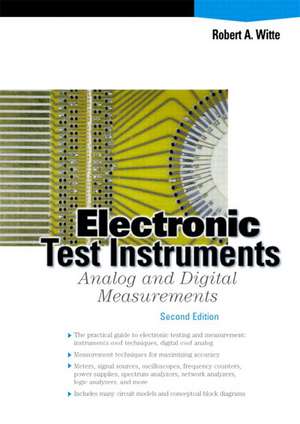Electronic Test Instruments: Analog and Digital Measurements
Autor Robert Witteen Limba Engleză Paperback – 28 feb 2002
Preț: 418.65 lei
Nou
Puncte Express: 628
Preț estimativ în valută:
80.13€ • 87.07$ • 67.36£
80.13€ • 87.07$ • 67.36£
Carte indisponibilă temporar
Doresc să fiu notificat când acest titlu va fi disponibil:
Se trimite...
Preluare comenzi: 021 569.72.76
Specificații
ISBN-13: 9780130668301
ISBN-10: 0130668303
Pagini: 400
Dimensiuni: 172 x 242 x 21 mm
Greutate: 0.62 kg
Ediția:Nouă
Editura: Prentice Hall
Locul publicării:Upper Saddle River, United States
ISBN-10: 0130668303
Pagini: 400
Dimensiuni: 172 x 242 x 21 mm
Greutate: 0.62 kg
Ediția:Nouă
Editura: Prentice Hall
Locul publicării:Upper Saddle River, United States
Cuprins
Preface.
Acknowledgments
1. Measurement Theory.
Electrical Quantities. Resistance. Polarity. Direct Current. Power. Alternating Current. RMS Value. Average Value. Crest Factor. Phase. AC Power. Nonsinusoidal Waveforms. Harmonics. Square Wave. Pulse Train. Combined DC and AC. Modulated Signals. Decibels. Absolute Decibel Values. Measurement Error. The Loading Effect. The Voltage Divider. Maximum Voltage Transfer. Maximum Power Transfer. Impedance. Instrument Inputs. Bandwidth. Rise Time. Bandwidth Limitation on Square Wave Digital Signals. Logic Families. References.
2. Voltmeters, Ammeters, and Ohmmeters Meters.
DC Voltmeters. AC Voltmeters. RF Probes. Ammeters. Ammeter Used as a Voltmeter. Voltmeter Used as an Ammeter. Current-Sense Resistor. AC Ammeter. Ohmmeters. Voltmeter-Ammeter Method. Series Ohmmeter. Current-Source Method. 4-Wire Ohms Measurements. Multimeters. Meter Range. Other Multimeter Functions. Specifications. References.
3. Signal Sources.
Circuit Model. Floating and Grounded Outputs. Sine Wave Sources. Imperfections in Sine Wave Sources. Function Generators. Pulse Generators. RF Signal Generators. Summary of Signal Sources. References.
4. The Oscilloscope Concept.
Analog Scope Block Diagram. Digital Scope Block Diagram. Sample Rate. Real-Time Sampling. Repetitive Sampling. Triggering. Acquisition/Sweep Control. Vertical Amplifier. Vertical Resolution. AC and DC Coupling. Bandwidth Limit. X-Y Display Mode. High Impedance Inputs. 50-W Inputs. Digital Acquisition and Display Techniques. Oscilloscope Specifications. Scopesmanship. Mixed Signal Oscilloscope. Oscilloscope Probes. Probe Compensation. Active Probes. Differential Measurements. High-Voltage Probe. Current Probes. References.
5. Basic Waveform Measurements.
Voltage Gain Measurement. Phase Measurement. Frequency Measurement (Lissajous Method). Digital Signal Measurement. Frequency Response Measurement. Square Wave Test. Linearity Measurement. Curve Tracer Measurement Technique. Diode I-V Characteristic. Resistor I-V Characteristic. Amplitude Modulation Measurement. Power Measurement. FFT Measurements. Basic Time Domain Reflectometry. References.
6. Electronic Counters.
Basic Frequency Counter. Frequency Dividers. Period Measurement. Reciprocal Counter. Universal Counter. Gated Counter Measurements. Timebase Accuracy. Input Impedance. Frequency Counter Specifications. Time Interval Analyzer. References.
7. Power Supplies.
Power Supplies. Circuit Model. Constant-Voltage Operation. Constant-Current Operation. CV-CC Operation. Overvoltage/Overcurrent Protection. Remote Sensing. Measurement Capability. Power Supply Specifications. References.
8. Spectrum and Network Analyzers.
Spectrum Analyzers. Bank-of-Filters Spectrum Analyzer. FFT Spectrum Analyzers. Wavemeters. Resolution Bandwidth. Narrowband and Broadband Measurements. Swept Spectrum Analyzers. Spectrum Analyzer Measurements. Network Analyzers. Distortion Analyzers. RF Power Measurements. RF Power Meter. References.
9. Logic Analyzers.
Logic Probes. Oscilloscope Logic Measurements. Logic Analyzers. Timing Analyzer. Glitch Detect. Digital Logic Test Example. State Analyzer. Data Formats. State Display. Timing Display. Microprocessor Measurement. Storage Qualification. Trigger Events and Sequencing. Microprocessor Program Flow. Logic Analyzer Probing. Combined Scope and Logic Analyzer. PC-Hosted Logic Analyzer. References.
10. Circuits for Electronic Measurements.
Resistance Measurement-Indirect Method. Output Resistance. Input Resistance. Bridge Measurements. RL and RC Circuits. Resonant Circuits. Diode Measurement Circuit. Instrument Connections. Attenuators. Power Splitters and Combiners Measurement Filters. References.
Appendix A: Table of Electrical Parameters, Units, and Standard Abbreviations.
Appendix B: Mathematical Derivations of Equations.
Average (Mean) Value of a Waveform. RMS Value of Waveform. Full-Wave Rectified Average Value of a Waveform. Bandwidth and Rise Time for a Single-Pole System. Frequency Response Due to Coupling Capacitor. Polar and Rectangular Formats. Resonant Frequency.
Appendix C: Binary, Hexadecimal, Decimal, and ASCII Table.
Index.
Notă biografică
ROBERT A. WITTE is an Engineering Manager with Agilent Technologies (formerly Hewlett-Packard), where he is responsible for the design and development of electronic test and measurement equipment. He has taught electrical engineering courses as an adjunct professor at two universities and has written two books and numerous magazine articles about test and measurement instrumentation.
Textul de pe ultima copertă
Electronic instruments: theory, applications, and real-world practice.
Robert A. Witte first introduces basic measurement theory, then covers each type of commonly used electronic test equipment. Using detailed examples, Witte shows how these systems are applied in real-world applications, introducing core functionality and showing how to choose the right instrument for each task. This new second edition has been updated throughout, reflecting the latest technologies and presenting extensive new coverage of digital oscilloscopes and power supplies.
- The practical guide to electronic test and measurement: instruments and techniques, digital and analog
- Measurement techniques for maximizing accuracy
- Meters, signal sources, oscilloscopes, frequency counters, power supplies, spectrum analyzers, network analyzers, logic analyzers, and more
- Includes many circuit models and conceptual block diagrams
Robert A. Witte first introduces basic measurement theory, then covers each type of commonly used electronic test equipment. Using detailed examples, Witte shows how these systems are applied in real-world applications, introducing core functionality and showing how to choose the right instrument for each task. This new second edition has been updated throughout, reflecting the latest technologies and presenting extensive new coverage of digital oscilloscopes and power supplies.
- Introduces essential measurement theory and explains its relationship to practical measurements
- Covers all mainstream test instruments, including meters, signal sources, oscilloscopes, frequency counters, power supplies, spectrum analyzers, network analyzers, logic probes, and logic analyzers
- Presents circuit models and conceptual block diagrams that clarify the behavior of complex circuits and instruments
- Explains key commonalities and differences between digital and analog instrumentation from the user's standpoint
- Introduces advanced circuit concepts and techniques that help users achieve higher quality measurements
- Illuminates important concepts such as loading effect, grounding, and bandwidth
Descriere
This book is for the student, technician or engineer who understands basic electronics and wants to learn more about electronic measurements. To use instruments effectively, it's necessary to understand basic measurement theory and how it relates to practical measurements.
